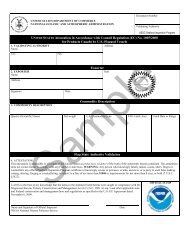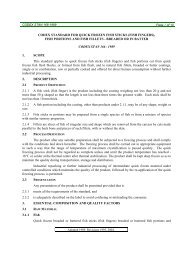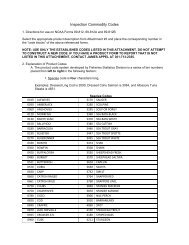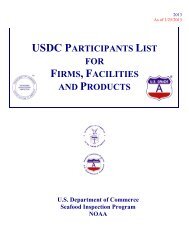Customs Labeling - Seafood Inspection Program
Customs Labeling - Seafood Inspection Program
Customs Labeling - Seafood Inspection Program
Create successful ePaper yourself
Turn your PDF publications into a flip-book with our unique Google optimized e-Paper software.
Chapter 1-United States <strong>Customs</strong> Service<br />
mistake, clarifying words shall be required. In such cases, the Commissioner of <strong>Customs</strong> shall specify in<br />
decisions published in the Federal Register and the <strong>Customs</strong> Bulletin the additional wording to be used in<br />
conjunction with the name of the colony, possession, or protectorate.<br />
[T.D. 72-262, 37 FR 20318, Sept. 29, 1972, as amended by T.D. 94-1, 58 FR 69472, Dec. 30, 1993]<br />
§ 134.46 Marking when name of country or locality other than country of origin appears.<br />
In any case in which the words ``United States,'' or ``American,'' the letters ``U.S.A.,'' any variation of such<br />
words or letters, or the name of any city or locality in the United States, or the name of any foreign country or<br />
locality other than the country or locality in which the article was manufactured or produced, appear on an<br />
imported article or its container, there shall appear, legibly and permanently, in close proximity to such words,<br />
letters or name, and in at least a comparable size, the name of the country of origin preceded by ``Made in,''<br />
``Product of,'' or other words of similar meaning.<br />
§ 134.47 Souvenirs and articles marked with trademarks or trade names.<br />
When as part of a trademark or trade name or as part of a souvenir marking, the name of a location in the<br />
United States or ``United States'' or ``America'' appear, the article shall be legibly, conspicuously, and<br />
permanently marked to indicate the name of the country of origin of the article preceded by ``Made in,''<br />
``Product of,'' or other similar words, in close proximity or in some other conspicuous location.<br />
Subpart F-Articles Found Not Legally Marked<br />
§ 134.51 Procedure when importation found not legally marked.<br />
(a) Notice to mark or redeliver. When articles or containers are found upon examination not to be legally<br />
marked, the port director shall notify the importer on <strong>Customs</strong> Form 4647 to arrange with the port director's<br />
office to properly mark the article or containers, or to return all released articles to <strong>Customs</strong> custody for<br />
marking, exportation, or destruction.<br />
(b) Identification of articles. When an imported article which is not legally marked is to be exported, destroyed,<br />
or marked under <strong>Customs</strong> supervision, the identity of the imported article shall be established to the satisfaction<br />
of the port director.<br />
(c) Supervision. Verification of marking, exportation, or destruction of articles found not to be legally marked<br />
shall be at the expense of the importer and shall be performed under <strong>Customs</strong> supervision unless the port<br />
director accepts a certificate of marking as provided for in §134.52 in lieu of marking under <strong>Customs</strong><br />
supervision.<br />
§ 134.52 Certificate of marking.<br />
(a) Applicability. Port directors may accept certificates of marking supported by samples of articles required<br />
to be marked, for which <strong>Customs</strong> Form 4647 was issued, from importers or from actual owners complying<br />
19<br />
Attachment #1<br />
(May 1985)






